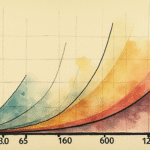Introduction
The International Monetary Fund (IMF) has revised its global economic growth projection upwards to 3% from the previous estimate of 2.8%, as stated in April. The impact of international trade tariffs has not been as severe as initially projected, according to the IMF’s economists led by Pierre Olivier Gourinchas.
Tariff Impact and Business Strategies
The IMF economists highlighted that the strategies employed by US companies, which anticipated imports before tariffs were imposed, played a crucial role in mitigating the adverse effects. Moreover, actual tariff rates have been lower than expected, improving financial conditions.
- US growth projections have been revised upwards to 1.9% for 2025 and 2% for 2026, reflecting adjustments of one and three decimal points respectively.
- Tariffs are acting as a supply shock in the US, impacting consumer prices, which is noticeable in the second half of the year. The IMF projects that inflation will remain above its 2% target even in 2026.
Eurozone and Key Countries
The IMF anticipates that the Eurozone will see a 1% GDP growth this year, two decimal points higher than the April forecast, and 1.2% for the following year, marking a fourth consecutive year of slow growth.
- Among the four European countries included in the update, Spain is expected to have the highest growth rate with a 2.5% GDP expansion this year and 1.8% in 2026.
- Germany is projected to grow slightly from zero, at 0.1% for this year and 0.9% for the next.
- Japan, the world’s fourth-largest economy, is forecasted to grow by 0.7% this year (with a slight upward adjustment of one decimal point) and 0.5% for 2026.
BRIC Countries and Latin American Economies
The revised global expectations only include specific details for around 20 countries. Among the BRIC nations, India is expected to remain the most dynamic economy with a 6.4% expansion this year, up from 6.2%. China follows closely with a 4.8% GDP growth, marking its third consecutive year of deceleration but with an upward revision of eight decimal points.
For Latin American economies, there are no detailed updates beyond Mexico and Brazil. Mexico is projected to grow by 0.2% this year and 1.4% next year, with rates significantly lower than its pre-pandemic potential of 2.5%.
- Brazil is expected to grow by 2.3%, an upward adjustment from the previously anticipated 2%. Russia is at the bottom with a projected growth of 0.9%, down from 1.2%.
- For the group, the IMF forecasts a growth rate of 2.2% (up from 2%) for the current year and 2.4% for the next.
Tariff Rates and Economic Activity
In April, the IMF estimated that the effective tariff rate for the US would be 24.4%. Following agreements with Japan and the European Union, this rate was reduced to 17.7%. The IMF experts warn that if the tariff rate increases above the previous 24.4% by year-end, it will act as a brake on US and global economic activity.
Key Questions and Answers
- Q: What is the revised global growth forecast by the IMF? A: The IMF has upwardly revised its global growth forecast to 3% from the previous estimate of 2.8%.
- Q: How have tariffs impacted the global economy? A: The impact of international trade tariffs has not been as severe as initially projected, with actual tariff rates being lower than expected and improving financial conditions.
- Q: What are the growth projections for key countries? A: The Eurozone is expected to grow by 1% this year and 1.2% next year, with Spain projected to have the highest growth rate at 2.5%. Germany and Japan are expected to grow slightly from zero, while Brazil is projected to expand by 2.3%.
- Q: How are BRIC countries faring according to the IMF? A: Among BRIC nations, India is expected to have the most dynamic economy with a 6.4% expansion this year, while China follows closely with a 4.8% GDP growth.
- Q: What does the IMF predict for Latin American economies? A: Mexico is projected to grow by 0.2% this year and 1.4% next year, while Brazil is expected to expand by 2.3%. Russia’s growth is projected at 0.9%.
- Q: How might tariff rates affect economic activity? A: If tariff rates increase above the previous 24.4% by year-end, it will act as a brake on US and global economic activity, according to the IMF experts.






